IN THIS ISSUE
- Nest colony takes a hit
- Augusta sturgeon saved
- Yes, hummers can smell
- Sprewell woodpeckers hatch
- Georgia has its first flamingos
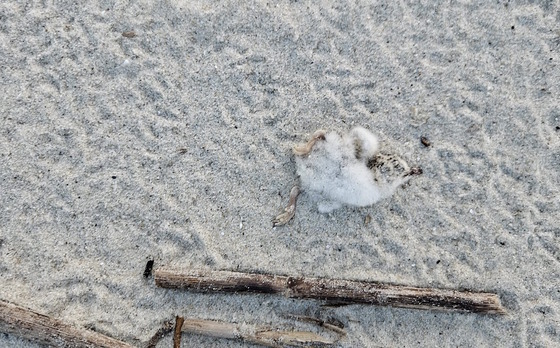 Dead least tern chick at Ogeechee Bar (Fletcher Smith/DNR)
A Memorial Day weekend incident that left two least tern chicks dead and ruined seven or more black skimmer nests underscores why people and pets should give beach birds a wide berth.
On Ogeechee Bar, a state-owned sandbar off Skidaway Island, DNR biologists found dog and human tracks around the dead terns and cracked skimmer eggs, even beyond “no dog” signs and in a roped-off nesting colony.
DNR’s Fletcher Smith, who researches shorebirds, said the chicks probably died from exposure to high temperatures after their parents were flushed. The young birds can’t thermoregulate and must be shaded from the sun by an adult.
Dogs in the nesting colony would keep parents away from chicks and eggs, “giving predators a chance to swoop in and eat the eggs, which is likely what happened,” Smith said.
Georgia beaches provide critical nesting and feeding sites for shorebirds and seabirds. The least tern colony on Ogeechee Bar is one of possibly three in the state. Only one other black skimmer nesting colony is known.
“There are over 200 nests on Ogeechee Bar right now and the chicks won't be able to fly until July,” Fletcher said. “So there is still a long period left where dogs could inflict serious damage.”
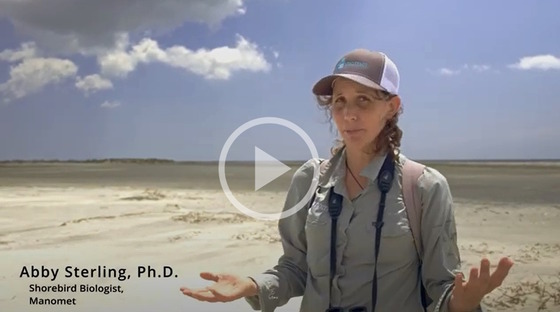 WHAT YOU CAN DO
When visiting a Georgia coast beach or sandbar:
- Avoid posted sites (eggs and chicks are camouflaged and easy to overlook).
- Walk below the high-tide line.
- Watch beach birds only from a distance.
- Back away from any nesting birds accidentally disturbed.
- Leave dogs home or keep them leashed when at a beach where they’re allowed.
Watch Manomet’s Dr. Abby Sterling on protecting beach birds (The Current).
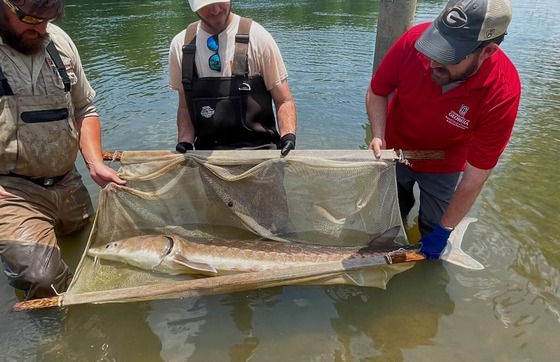 DNR's Hunter Roop, from left, Aaron Gray and UGA's Adam Fox with the wayward fish (Jada Walker/WRDW-TV)
A wandering Atlantic sturgeon is back in its home river following a rescue in Augusta.
Answering a citizen’s call about the endangered species on May 23, DNR fisheries biologist Aaron Gray met the caller at the Old Waynesboro Road bridge crossing Spirit Creek. The 6-foot-long fish circled in a small pool below.
Considering that the creek had been higher from recent rains, Gray said the sturgeon likely swam up the Savannah River, took a wrong turn into the tributary “and was stuck when the waters receded.” ...
Read DNR's blog post about the rescue. See the fish returned to the Savannah.
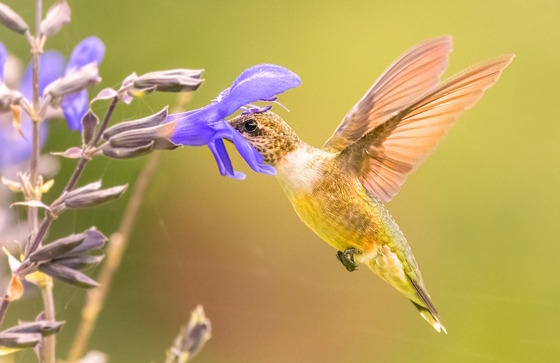 A female ruby-throated hummingbird foraging (Jenny Burdette/GNPA)
By TERRY W. JOHNSON
When I tell you hummingbirds can smell, I’m don’t mean they possess an odor, like a pair of dirty socks. Instead, I am referring to what biologists recently learned: that hummers have a sense of smell.
Because hummingbirds are such amazing birds, it stands to reason that their senses, from excellent sight to acute hearing, are finely tuned to their environment.
However, it has been generally accepted that hummingbirds can’t smell. …
Read Terry’s column for more on the belief and the research that upended it.
Terry W. Johnson is a retired DNR manager and executive director of TERN, friends group of the Wildlife Conservation Section. Check out past columns and his blog. Permission is required to reprint a column.
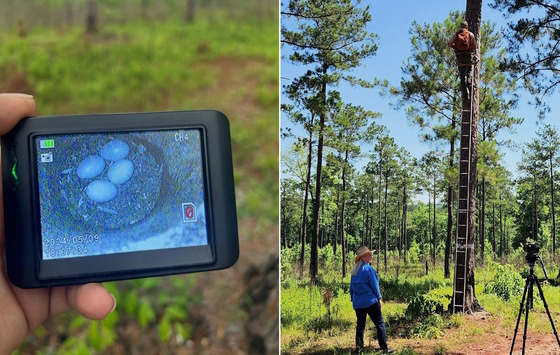 Eggs, left, and banding chicks at Sprewell with Georgia Outdoors' Sharon Collins (Nathan Klaus/DNR)
Score one, or more, for red-cockaded woodpeckers at Sprewell Bluff.
Two of the three pairs moved from Fort Stewart to the wildlife management area near Thomaston last winter have nested, laid eggs and now hatched chicks. DNR has banded two of the nestlings so far to help monitor them.
Reintroduced to Sprewell Bluff after an almost 50-year absence, endangered red-cockaded woodpeckers are symbolic of a partner-supported effort to restore longleaf pine savannas at the WMA (“Rare birds return,” December).
But with four of the six newcomers already raising young, the woodpeckers are also exceeding the usual 50-percent success rate for translocating this species.
Below in Wild Facts: why cross-foster red-cockaded woodpeckers.
 DNR sea turtle technician Joyce Sanks with an egg sampled from a Sapelo Island nest (Mark Dodd/DNR)
Loggerhead sea turtle nesting season is in full swing. In the wake of the first nests logged by Georgia Sea Turtle Cooperative members May 5, the state’s primary nesting marine turtle has laid more than 700 nests on barrier island beaches in what is predicted to be an average year. Daily updates.
Recovering America’s Wildlife Act to help restore and conserve species has added sponsors – U.S. Sens. Katie Britt, R-Ala., and Amy Klobuchar, D-Minn. – while America’s Wildlife Habitat Conservation Act cleared the House Natural Resources Committee on a party-line vote: Republicans for, Democrats against.
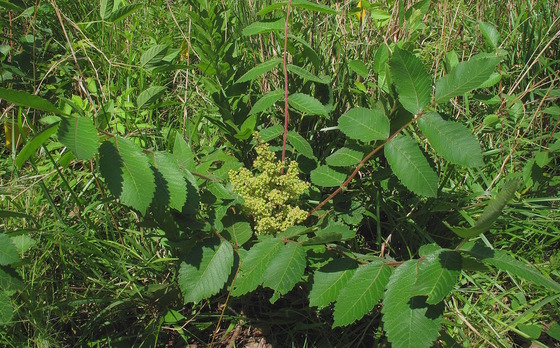 Dwarf sumac (shown here in Elbert County) will hopefully soon take root on the Chattahoochee (Alan Cressler)
Endangered dwarf sumac has been planted on the Chattahoochee National Forest and more than 330 hooded pitcherplants saved from a St. Marys development now grace wetlands at Ceylon Wildlife Management Area. The sumac project, years in the making, required formal agreements. Volunteers rescued the pitcherplants and DNR cared for them at the Altama Plantation WMA nursery.
And they’re off! Both chicks in the rare-for-Georgia nest of common ravens at Tallulah Gorge State Park fledged in mid-May, with the parents seen bringing food to the demanding fledglings in a nearby tree (“Quoth the raven,” May).
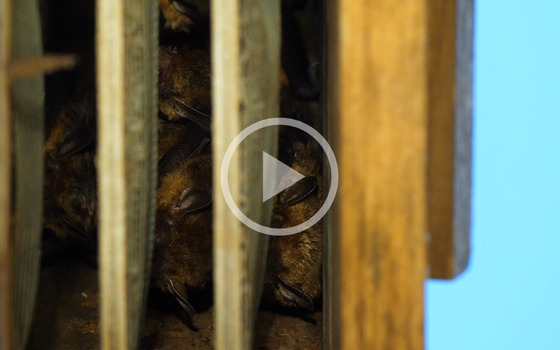 Video: DNR's Katrina Morris explains how to track roosting bats (DNR)
Got bats? Help DNR better understand and conserve them in Georgia by volunteering to count bats at a roost near you this summer: It’s easy, interesting and wildlife friendly.
Chattahoochee Fall Line Wildlife Management Area is 2,341 acres larger, with The Nature Conservancy recently selling nine tracts to DNR for about $3 million. The properties, part of the Chattahoochee Fall Line Partnership area prioritized for restoring longleaf pine and buffering the U.S. Army’s Fort Moore, will be managed by DNR and the Conservancy as part of the WMA.
 American flamingo feeding on Little St. Simons Island (Cody Cox/UGA)
Quick hits:
- Four American flamingos spotted last month on Little St. Simons Island represent Georgia's first record in the wild of the hot-pink waders.
- The second of two free-fishing Saturdays celebrating National Fishing and Boating Week is June 9, when neither fishing license, trout license nor lands pass is needed to wet a line.
- Considering the state has three black bear populations – mountains, along the Ocmulgee River in middle Georgia and in and around Okefenokee Swamp – plus that bears often roam even farther, it pays to be BearWise.
- What’s beautiful and rare but fading on hardwood forest slopes even as you read this? Find out in this Georgia Wildlife blog post.
- New this year, duck hunters will receive and carry an electronic federal duck stamp, with the e-stamp valid until July 1, 2025, and paper copies mailed to hunters (but not required for use when hunting).
 Lindsay Thomas, left, with Natural Resources board member Nancy Addison and Chair Joe Hatfield (DNR)
Names in the news: Southeast Georgia native and former Congressman Lindsay Thomas has received the 2023 Rock Howard Award from the Georgia Board of Natural Resources. Named after the state’s first Environmental Protection Division director, the award recognizes significant contributions in support of DNR’s mission. Board Chair Joe Hatfield called Thomas’ leadership in the House from 1983 to 1993 – including co-founding the Congressional Sportsmen’s Caucus – and continued conservation work in the state “a source of pride for Georgia conservationists." In other honors, Atlanta Botanical Garden’s Dr. Emily Coffey earned the Center for Plant Conservation’s 2024 Star Award for her work with imperiled native plants and the Georgia Chapter of Safari Club International named DNR senior wildlife biologist Theron Menken its Game Management Biologist of the Year. The DNR Wildlife Resources Division has two new section chiefs: Kaitlin Goode in Communication, Education and Outreach, and Lee Taylor in Game Management. Taylor’s promotion from regional supervisor to directing the agency’s game, land and wildlife management efforts follows the retirement of former Chief Alan Isler. Goode, hired in 2019 to lead the division’s Urban Wildlife Program, fills a new position shepherding efforts from communications to educational programs to initiatives such as Outdoors Beyond Barriers for people with impaired mobility.
WHAT YOU MISSED ...
In the previous Georgia Wild:
- Tallulah Gorge raven nest
- Lewis Island: land of giants
- Cicadas and copperheads
- Bluebirds brooding in odd places
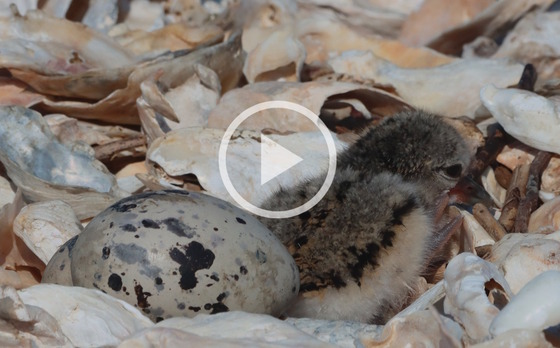 Newly hatched American oystercatcher chick among unhatched eggs (Tim Keyes/DNR)
(above) American oystercatcher chick and adult call as the chick begins breaking out of its shell on a Georgia shell rake, Tim Keyes/DNR
"How Fire Can Restore a Forest," The Nature Conservancy
Kemp's ridley sea turtle after nesting on Cumberland Island, Georgia Sea Turtle Cooperative
Game of river otter tag, DNR
"Beachgoers and their dogs threaten nesting shorebirds," The Current
"Right whale calving season: How many were born, died," USA Today. Also: "Whale mom believed to have lost calf" (CBS News), "Remains of whale found off Novia Scotia" (Toronto Star), "First right whale seen off Canada in 2024 entangled" (WJAR-TV, Rhode Island), "Better way to find right whales" (The Wildlife Society, study), "This whale vanished; his species can be saved" (The Washington Post).
"Four important questions about bird flu, answered," Smithsonian
"Georgia loggerhead nesting season underway," WJAX/WFOX-TV (Jacksonville, Fla.). Also: WSB-TV (Atlanta), Now Habersham, WABE-FM (90.1, Atlanta), others.
(+audio) "Not-so-common ravens nesting at Tallulah Gorge," WABE-FM (90.1, Atlanta). Also: Georgia Public Broadcasting, The (Gainesville) Times.
"Restoring rare shoals spider lilies," The Atlanta Journal-Constitution
"Bill for Ocmulgee park receives DNR support," The Albany Herald and others
"Snake season in Georgia: safety tips and more," Patch.com
"Mangroves on move (including into Georgia)," U.S. Fish and Wildlife Service
"When wildlife invade your space, avoid potential conflict," Grice Connect
"Birds Georgia receives grant for 'Hooch habitat restoration," Rough Draft Atlanta
"Young Georgia artists receive honors in Fish Art Contest," Grice Connect
"Nevada: DNA tests show suspected wolves were coyotes," The Associated Press
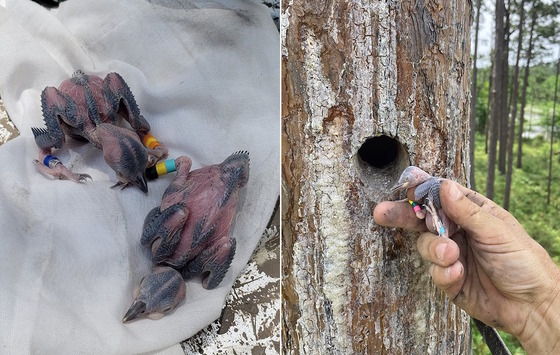 "Cross-foster" chicks banded and moved to new nest-cavity homes in the Red Hills (DNR)
The recovery of endangered red-cockaded woodpeckers sometimes stumbles over genetics, such as when inbreeding at small, isolated populations results in fewer eggs hatching or chicks surviving. This spring, DNR and Tall Timbers are exploring whether “cross-fostering” can boost genetic diversity at woodpecker clusters in the Red Hills region of southwest Georgia and north Florida. Chicks 7-10 days old and similar in age and weight are banded and quickly swapped between nests. One chick is swapped per nest and only nests with at least two are considered. Biologist Joe Burnam, who leads DNR’s work with the rare woodpeckers, said the birds are monitored to document their sex and see if they fledge and stay at their new address. If cross-fostering works, it could provide an easier and more effective gene-mixing option than the current practice of moving 5- to 6-month-old woodpeckers.
CREDIT
Masthead: female ruby-throated hummingbird foraging (Jenny Burdette/GNPA)
Top
|